How to make a House Atreides vest
To serve a noble House of the Landsraad a uniform certainly helps define where yout allegiances lie. And if one is privileged enough serve the Duke Leto Atreides in the height of his influence, a little pomp and circumstance is warranted. Thus I have made some additions and alterations to a basic thrift store vest/waistcoat in order to fit right in with the famed House at the center of the universe's intrigues in Frank Herbert's Dune.
And the piece alone...
To make this vest I combined some of the key elements of the Atreides uniforms seen in the 1984 film, into a vest that is a bit more like that of a courtier than that of soldier. The colors of Atreides house in the book is green, black, and red. In the 1984 film they actually keep pretty close to that, the some of the Caladan uniforms appear black but are actually a dark green. So I altered and added some details like the buttons, aiguillette, and rank badge.
Vest materials
-Black elaborate vest with corset-lace back
-8 green pearlescent buttons
-2 gold eagle buttons
-Red acrylic paint
Aiguillette materials
-4 yards of red curtain twisted cord
-1 gold bead cone
Rank badge materials
-Black faux leather
-Jewelry pin
-Red "peel-and-stick" craft felt
-Yellow and white craft felt
Tools
-Scissors
-Black thread/needle
-Superglue
-Small paintbrush
1. Gather the materials
I bought this vest from a thrift store for $5, an interesting waistcoat with the hint of tails and a corset-lace back. The buttons were found at a fabric store for about $3 per package, though you could probably scrounge something similar and cheaper in the bargain bins of thrift stores or flea markets.
The aiguillette is made from a red 3/16th width curtain cord, bought from a roll at a fabric store. Bead cones are a useful size and shape for the "aglet", I found this gold-colored one in the beading section of a craft store. And finally I bought this craft felt and used faux leather scraps for the badge.
2. Replace the buttons
The first project here was to replace the decorative buttons that came with the vest. The rustic gold-colored buttons don't really bring out much, so I decided to add a touch of Atreides green. These iridescent green buttons are also meant to bring out the green of the dress and necklace that will be going with the costume.
Sew the buttons into place, taking care to use multiple stitches to ensure they stay in place.
Finish attaching all the buttons.
When finished, I decided to add a pair of buttons to the shoulders. I found a pair of gold eagle buttons.
I painted the eagles red to match the Atreides red hawk emblem.
I then used safety pins to attach them to the tops of the vest shoulders, so that I could remove them at will.
3. Make the aiguillette
To give the vest a bit more pomp and circumstance, I decided to lift some military embellishments particularly seen in the 1984 Dune film. I was particularly intrigued by the aiguillette seen in Paul and Leto's Caladan dress uniforms, and thus went down a rabbit hole of militaria. Aiguillettes are a holdover from a time where soldiers needed ties to attach armor together, seen in 15th and 16th century European portraits. They still have a place in many modern dress uniforms, though they don't really have a practical purpose except in helping determine rank and purpose of the person wearing it. They usually consist of braided cords ending in a metal "aglet" to keep it from unravelling, but can span the range of simple to ornate and be worn in several ways. Just to give you some ideas on this, here are some examples:
While fascinating, I got sort of cross-eyed trying to determine what was the "right" way to try to replicate an aiguillette. Turns out, there's very little out there on how to make or wear an aiguillette (though to be fair I didn't spend much time pouring over army manuals for dress codes). The simpler "cadet" form seen in the second example is easy enough to replicate, but damn it I might as well go for the ridiculous across-the-chest version. I ended up focusing on ignoring proper stuff and just went for replicating the look of the Atreides aiguillette. After combing the internet I found a serviceable aiguillette tutorial by Lawbnd, though it's very short of details.
First take one end of the cord and tie off a loop that will be big enough to hook over the gold button. Then figure how long you want the braided section. Fancier aiguillettes are part braided, part unbraided. The braided section in the Caladan uniform appears to be one length across the front. I played around with figuring out how long the braided section would have to be to, and for my frame estimated it to be about 20 inches from the top of the shoulder to loop down to the buttons (though longer than that would likely be even better).
To braid the cord, first create this loose loop seen below.
The end at the bottom left is the top of what will become the braid. Extend the loop extending lengthwise above to be at least 20 inches long.
Next, while keeping that loop the same 20 inches length, use the loose end of the cord to start braiding. It's kind of hard to explain, but the bottom line is that the loop extending 20 inches is the guideline for how long the braid will be. It's a typical 3-strand braid, a pretty basic braid that used for braiding hair and your typical first grader's friendship bracelet. If you've never braided before, here's a demonstration of this technique. The only difference here is that only one strand is mobile.
The key to any braid is to keep it as tight and uniform as possible. The photo below is me using my foot to keep the tension on it, though this first attempt still was lumpy and I ended up unbraiding and rebraiding again.
Keep packing the braids in to the end of the loop, and then tie it off. Next I attached the braid to the uniform, using the small first loop to slip over the shoulder button.
Then I used one of the tiny hooks that holds the vest closed to attached the bottom part of the braid.
Then bring the unbraided cord back up to the shoulder, threading the cord through the loop that's attached to the shoulder button.
And then have it drop down over the back of the shoulder and come back to the front under the arm. I hitched it to the front of the vest with a bobby pin.
Figure out how long you want the end of the cord to be, usually about 6-8 inches from where it's attached to the vest. Finish off with a fancy knot!
And then add the "aglet" to the aiguillette. Be careful with cutting the cord to size, it unravels at the drop of a hat. I used a decorative bead cone and a bit of superglue to finish it off.
I ultimately decided to wear this aiguillette on the left side of the uniform rather than on the right, as is seen in Paul and Leto's uniforms. If you wanted to make a Paul or Leto costume, I'd say definitely wear it on the right like they do. In the 1984 film the aiguillette is only seen on the Duke and his heir, seeming to use the aiguillette as a way to show who is the voice of House Atreides. But since the costume I'm making is trying to make a uniform for a Ducal representative/Mentat in the Corrino court rather than Atreides blood, left it is. Why would left or right make any difference? From what I read in modern militaries, right or left does make a difference. For example in the U.S. if the more ornate aiguillette is worn on the right the person is an aide for the President or Vice President, on the left means an aide for the Secretary of Defense, Service Secretaries, or other military attaches. I know what you're thinking...who cares? Well I care damn it! You know how much I read about aiguillettes? So left it is.
4. Make the rank badge
That might be a totally inaccurate term for this, but what I mean is the embroidered patches on the left breast of the uniform. The badge varies somewhat across Caladan uniforms. The badges Paul and Duncan Idaho wear are identical, with two red triangles and one white. Gurney Halleck wears something similar, but with two white triangles and one red. By virtue of being the head of House Atreides, Duke Leto wears instead the red hawk with wings displayed.
First I estimated the size of the badge and drew up a pattern. Eventually I settled on the triangles being 1.25 inch sides, and the rectangle being 1 x 2.75 inches.
Then I cut out the black piece of faux leather as the background of the badge. I then sewed a jewelry pin to the top center back of the faux leather.
For the colored triangles, rectangle, and cross-hatching I cut out pieces of felt. The "peel-and-stick" craft felt I used for the red pieces were especially useful.
Then I put it altogether, using the adhesive of the peel-and-stick felt and a few drops of superglue.
5. Finishing touches
Once the buttons, aiguillette, and badge are in place, the vest is complete! Do not forget to pop that collar, it's essential! Further alterations could be made, such as adding the epaulets, etc. But I liked this simplified version, it has enough detail to evoke the feel of the film without copying it exactly. Since my goal was to use this as part of an Atreides Mentat costume, this balance seemed a good fit. Anyway good luck and keep crafting!
And the piece alone...
To make this vest I combined some of the key elements of the Atreides uniforms seen in the 1984 film, into a vest that is a bit more like that of a courtier than that of soldier. The colors of Atreides house in the book is green, black, and red. In the 1984 film they actually keep pretty close to that, the some of the Caladan uniforms appear black but are actually a dark green. So I altered and added some details like the buttons, aiguillette, and rank badge.
Vest materials
-Black elaborate vest with corset-lace back
-8 green pearlescent buttons
-2 gold eagle buttons
-Red acrylic paint
Aiguillette materials
-4 yards of red curtain twisted cord
-1 gold bead cone
Rank badge materials
-Black faux leather
-Jewelry pin
-Red "peel-and-stick" craft felt
-Yellow and white craft felt
Tools
-Scissors
-Black thread/needle
-Superglue
-Small paintbrush
1. Gather the materials
I bought this vest from a thrift store for $5, an interesting waistcoat with the hint of tails and a corset-lace back. The buttons were found at a fabric store for about $3 per package, though you could probably scrounge something similar and cheaper in the bargain bins of thrift stores or flea markets.
The aiguillette is made from a red 3/16th width curtain cord, bought from a roll at a fabric store. Bead cones are a useful size and shape for the "aglet", I found this gold-colored one in the beading section of a craft store. And finally I bought this craft felt and used faux leather scraps for the badge.
2. Replace the buttons
The first project here was to replace the decorative buttons that came with the vest. The rustic gold-colored buttons don't really bring out much, so I decided to add a touch of Atreides green. These iridescent green buttons are also meant to bring out the green of the dress and necklace that will be going with the costume.
Sew the buttons into place, taking care to use multiple stitches to ensure they stay in place.
Finish attaching all the buttons.
When finished, I decided to add a pair of buttons to the shoulders. I found a pair of gold eagle buttons.
I painted the eagles red to match the Atreides red hawk emblem.
I then used safety pins to attach them to the tops of the vest shoulders, so that I could remove them at will.
3. Make the aiguillette
To give the vest a bit more pomp and circumstance, I decided to lift some military embellishments particularly seen in the 1984 Dune film. I was particularly intrigued by the aiguillette seen in Paul and Leto's Caladan dress uniforms, and thus went down a rabbit hole of militaria. Aiguillettes are a holdover from a time where soldiers needed ties to attach armor together, seen in 15th and 16th century European portraits. They still have a place in many modern dress uniforms, though they don't really have a practical purpose except in helping determine rank and purpose of the person wearing it. They usually consist of braided cords ending in a metal "aglet" to keep it from unravelling, but can span the range of simple to ornate and be worn in several ways. Just to give you some ideas on this, here are some examples:
While fascinating, I got sort of cross-eyed trying to determine what was the "right" way to try to replicate an aiguillette. Turns out, there's very little out there on how to make or wear an aiguillette (though to be fair I didn't spend much time pouring over army manuals for dress codes). The simpler "cadet" form seen in the second example is easy enough to replicate, but damn it I might as well go for the ridiculous across-the-chest version. I ended up focusing on ignoring proper stuff and just went for replicating the look of the Atreides aiguillette. After combing the internet I found a serviceable aiguillette tutorial by Lawbnd, though it's very short of details.
First take one end of the cord and tie off a loop that will be big enough to hook over the gold button. Then figure how long you want the braided section. Fancier aiguillettes are part braided, part unbraided. The braided section in the Caladan uniform appears to be one length across the front. I played around with figuring out how long the braided section would have to be to, and for my frame estimated it to be about 20 inches from the top of the shoulder to loop down to the buttons (though longer than that would likely be even better).
To braid the cord, first create this loose loop seen below.
The end at the bottom left is the top of what will become the braid. Extend the loop extending lengthwise above to be at least 20 inches long.
Next, while keeping that loop the same 20 inches length, use the loose end of the cord to start braiding. It's kind of hard to explain, but the bottom line is that the loop extending 20 inches is the guideline for how long the braid will be. It's a typical 3-strand braid, a pretty basic braid that used for braiding hair and your typical first grader's friendship bracelet. If you've never braided before, here's a demonstration of this technique. The only difference here is that only one strand is mobile.
The key to any braid is to keep it as tight and uniform as possible. The photo below is me using my foot to keep the tension on it, though this first attempt still was lumpy and I ended up unbraiding and rebraiding again.
Keep packing the braids in to the end of the loop, and then tie it off. Next I attached the braid to the uniform, using the small first loop to slip over the shoulder button.
Then I used one of the tiny hooks that holds the vest closed to attached the bottom part of the braid.
Then bring the unbraided cord back up to the shoulder, threading the cord through the loop that's attached to the shoulder button.
And then have it drop down over the back of the shoulder and come back to the front under the arm. I hitched it to the front of the vest with a bobby pin.
Figure out how long you want the end of the cord to be, usually about 6-8 inches from where it's attached to the vest. Finish off with a fancy knot!
And then add the "aglet" to the aiguillette. Be careful with cutting the cord to size, it unravels at the drop of a hat. I used a decorative bead cone and a bit of superglue to finish it off.
I ultimately decided to wear this aiguillette on the left side of the uniform rather than on the right, as is seen in Paul and Leto's uniforms. If you wanted to make a Paul or Leto costume, I'd say definitely wear it on the right like they do. In the 1984 film the aiguillette is only seen on the Duke and his heir, seeming to use the aiguillette as a way to show who is the voice of House Atreides. But since the costume I'm making is trying to make a uniform for a Ducal representative/Mentat in the Corrino court rather than Atreides blood, left it is. Why would left or right make any difference? From what I read in modern militaries, right or left does make a difference. For example in the U.S. if the more ornate aiguillette is worn on the right the person is an aide for the President or Vice President, on the left means an aide for the Secretary of Defense, Service Secretaries, or other military attaches. I know what you're thinking...who cares? Well I care damn it! You know how much I read about aiguillettes? So left it is.
4. Make the rank badge
That might be a totally inaccurate term for this, but what I mean is the embroidered patches on the left breast of the uniform. The badge varies somewhat across Caladan uniforms. The badges Paul and Duncan Idaho wear are identical, with two red triangles and one white. Gurney Halleck wears something similar, but with two white triangles and one red. By virtue of being the head of House Atreides, Duke Leto wears instead the red hawk with wings displayed.
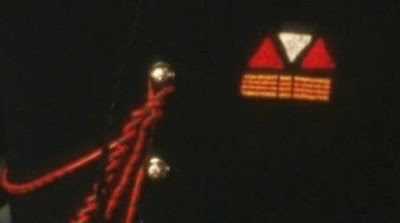 |
| Paul Atreides badge |
First I estimated the size of the badge and drew up a pattern. Eventually I settled on the triangles being 1.25 inch sides, and the rectangle being 1 x 2.75 inches.
Then I cut out the black piece of faux leather as the background of the badge. I then sewed a jewelry pin to the top center back of the faux leather.
For the colored triangles, rectangle, and cross-hatching I cut out pieces of felt. The "peel-and-stick" craft felt I used for the red pieces were especially useful.
Then I put it altogether, using the adhesive of the peel-and-stick felt and a few drops of superglue.
5. Finishing touches
Once the buttons, aiguillette, and badge are in place, the vest is complete! Do not forget to pop that collar, it's essential! Further alterations could be made, such as adding the epaulets, etc. But I liked this simplified version, it has enough detail to evoke the feel of the film without copying it exactly. Since my goal was to use this as part of an Atreides Mentat costume, this balance seemed a good fit. Anyway good luck and keep crafting!
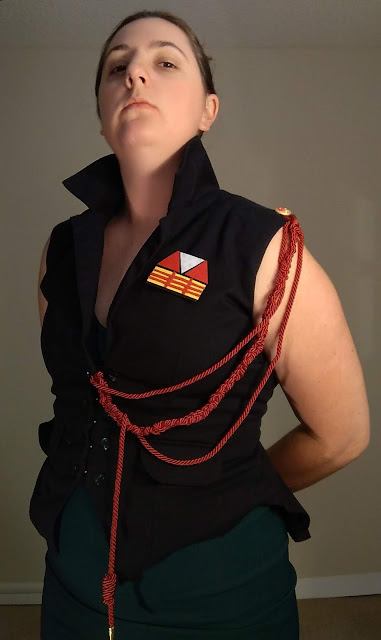








































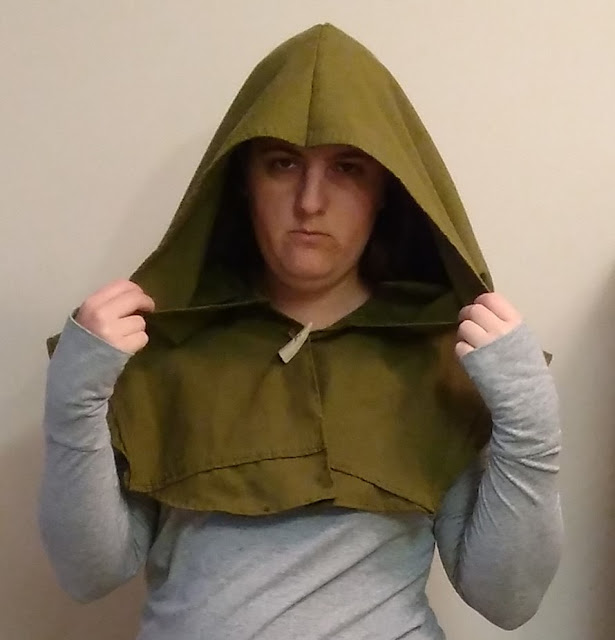
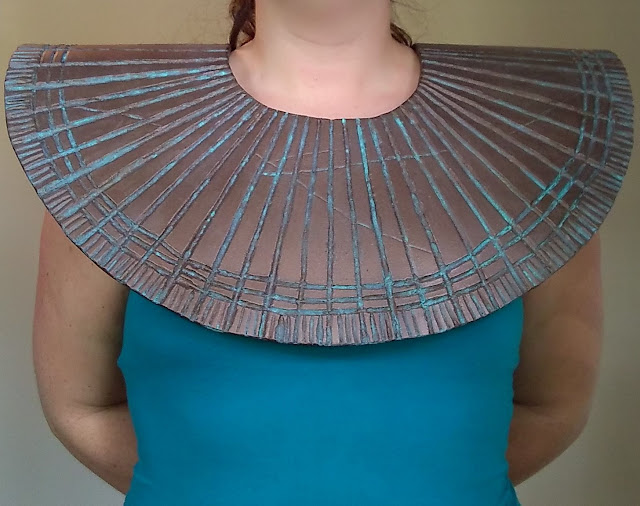
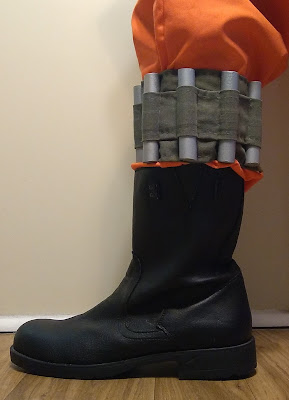
Comments
Post a Comment